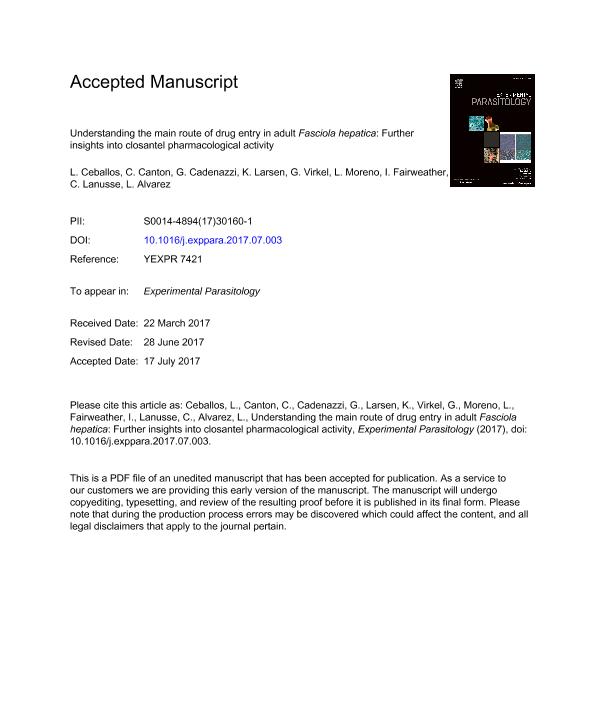Artículo
Understanding the main route of drug entry in adult Fasciola hepatica: Further insights into closantel pharmacological activity
Ceballos, Laura ; Cantón, Candela
; Cantón, Candela ; Cadenazzi, Guillermo Luis
; Cadenazzi, Guillermo Luis ; Larsen, Karen Elizabeth
; Larsen, Karen Elizabeth ; Virkel, Guillermo Leon
; Virkel, Guillermo Leon ; Moreno, L.; Fairweather, I.; Lanusse, Carlos Edmundo
; Moreno, L.; Fairweather, I.; Lanusse, Carlos Edmundo ; Alvarez, Luis Ignacio
; Alvarez, Luis Ignacio
 ; Cantón, Candela
; Cantón, Candela ; Cadenazzi, Guillermo Luis
; Cadenazzi, Guillermo Luis ; Larsen, Karen Elizabeth
; Larsen, Karen Elizabeth ; Virkel, Guillermo Leon
; Virkel, Guillermo Leon ; Moreno, L.; Fairweather, I.; Lanusse, Carlos Edmundo
; Moreno, L.; Fairweather, I.; Lanusse, Carlos Edmundo ; Alvarez, Luis Ignacio
; Alvarez, Luis Ignacio
Fecha de publicación:
10/2017
Editorial:
Academic Press Inc Elsevier Science
Revista:
Experimental Parasitology
ISSN:
0014-4894
Idioma:
Inglés
Tipo de recurso:
Artículo publicado
Clasificación temática:
Resumen
Closantel (CLS) is highly effective against adult liver flukes after its oral or subcutaneous (sc) administration in ruminants. Trans-tegumental diffusion and oral ingestion are the two potential routes available for the entry of drugs into Fasciola hepatica. The work reported here contributes to improve the understanding of CLS pharmacology. The main goals of were: I) to determine the pattern of in vivo CLS accumulation into adult F. hepatica and relevant tissues in CLS-treated sheep; II) to investigate the influence of the physicochemical composition of the incubation medium on the CLS diffusion process into adult F. hepatica; III) to assess the ovicidal activity of CLS against F. hepatica eggs; and IV) to investigate the in vivo effect of CLS treatment on glutathione S-transferases activity in adult liver flukes exposed to CLS. Fourteen healthy sheep were each orally infected with 75 F. hepatica metacercariae. Sixteen (16) weeks after infection, animals were treated with CLS by oral (n = 6, 10 mg/kg) or sub-cutaneous (sc) (n = 6, 5 mg/kg) route. At 12, 24 and 36 h post-treatment, animals were sacrificed (n = 2) and samples of blood, bile and adult F. hepatica were collected. In addition, flukes recovered from non-treated sheep (n = 2) were ex vivo incubated (60 min) in the presence of CLS in either RPMI or bile as incubation medium. CLS concentration was measured by HPLC. The ovicidal activity of CLS was investigated using eggs obtained from the bile of untreated sheep. Finally, glutathione S-transferase activity in F. hepatica recovered from untreated and CLS-treated sheep was assessed. In the in vivo studies, the highest CLS concentrations were measured in plasma and adult liver flukes. A positive correlation was observed between CLS concentration in plasma and in F. hepatica. Results obtained in the current work indicate that the in vivo accumulation of CLS into adult liver flukes occurs mainly by the oral route. After ex vivo incubation, the uptake of CLS by the parasite was markedly diminished in the presence of bile compared with that observed in the presence of RPMI as incubation medium. CLS lacks ovicidal activity at therapeutically relevant concentrations. Lastly, CLS significantly increased glutathione S-transferase activity in flukes recovered at 12 h (oral treatment) and 24 h (sc treatment), compared to the control liver flukes.
Palabras clave:
Closantel
,
Drug Distribution
,
Fasciola Hepatica
Archivos asociados
Licencia
Identificadores
Colecciones
Articulos(CIVETAN)
Articulos de CENTRO DE INVESTIGACION VETERINARIA DE TANDIL
Articulos de CENTRO DE INVESTIGACION VETERINARIA DE TANDIL
Citación
Ceballos, Laura; Cantón, Candela; Cadenazzi, Guillermo Luis; Larsen, Karen Elizabeth; Virkel, Guillermo Leon; et al.; Understanding the main route of drug entry in adult Fasciola hepatica: Further insights into closantel pharmacological activity; Academic Press Inc Elsevier Science; Experimental Parasitology; 181; 10-2017; 23-29
Compartir
Altmétricas



